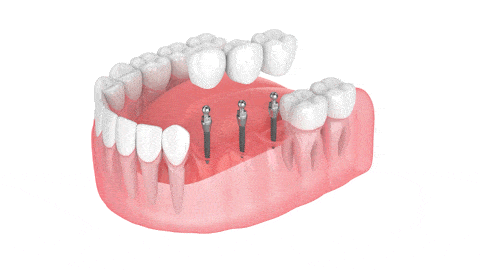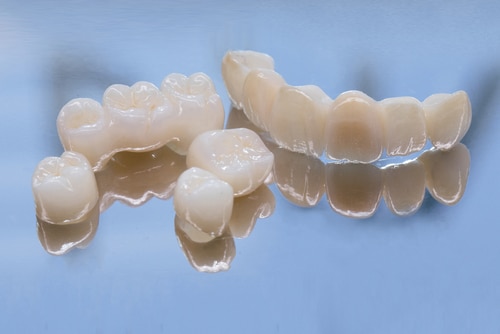Dental Bridges in Countryside, IL
Around 50% percent of people (178 million) in the U.S. have at least one missing tooth. Missing teeth can make it more difficult to eat the foods you love, affect your ability to speak clearly, and even change your facial structure. Dental bridges are one of the most popular ways to replace missing teeth. Learn more about what getting a dental bridge at Hope Dental is like.
What Are Dental Bridges?
 A dental bridge is a device that fills the gap created by a missing tooth. The bridge uses the neighboring teeth as anchors to hold a false tooth (pontic) in place. Although pontics can be made of many different materials, the most common option is porcelain because of its natural appearance.
A dental bridge is a device that fills the gap created by a missing tooth. The bridge uses the neighboring teeth as anchors to hold a false tooth (pontic) in place. Although pontics can be made of many different materials, the most common option is porcelain because of its natural appearance.
Dental bridges replace teeth that have been lost due to reasons like:
- Decay
- Injury
- Gum disease
If you experience bite problems because of missing teeth that make it more difficult to chew, feel self-conscious when you smile, or feel pain because of uneven stress and pressure on your jaw and other teeth, you might benefit from a dental bridge.
There are four main types of dental bridges:
- Traditional
- Cantilever
- Maryland
- Implant-supported
The traditional dental bridge uses two crowns placed on neighboring teeth to hold the pontic in place. It is the most popular option, and it can be effective if you have natural teeth on both sides of the gap.
A cantilever dental bridge is similar to the traditional bridge, except that it uses just one crown to help the pontic in place. It is appropriate for people who have a healthy tooth on just one side of the gap.
Like a traditional bridge, a Maryland dental bridge is supported by two neighboring teeth. But instead of crowns that hold the pontic in place, it relies on a metal or porcelain framework that bonds to the back of the neighboring teeth. For this type of bridge, you must have healthy natural teeth on either side of the gap.
An implant-supported dental bridge uses dental implants instead of crowns to hold the false tooth in place. Implant-supported dental bridges are very stable tooth replacements that work well for people who have a limited number of teeth.
Benefits of Dental Bridges
Dental bridges can help restore your smile while allowing you to chew more comfortably. People who have missing teeth might struggle to eat the foods they love, making it difficult to get proper nutrition. Dental bridges can once again allow you to eat all types of foods.
Once you lose a tooth, your jawbone starts to deteriorate. It relies on the root of your teeth to provide stimulation when you chew. But if you have missing teeth, the jawbone does not receive that stimulation.
The more teeth you lose, the worse this problem can be, eventually causing severe bone loss that contributes to the loss of more teeth. Dental bridges, especially those that use implants, can reduce the chances of experiencing bone loss.
Losing teeth can also make speaking more difficult. Your tongue must touch your teeth to make consonants, so gaps in your mouth can prevent you from enunciating correctly. Dental bridges get rid of those gaps so that you can speak more easily.
Although the roots of your teeth keep them in place, neighboring teeth also play a role. If you have gaps between teeth, the surrounding teeth might shift out of place and cause problems with your bite. Dental bridges fill in these gaps to keep neighboring teeth from shifting.
Getting Dental Bridges
When you schedule your consultation with Dr. Russell Ras at Hope Dental, we will begin by assessing your mouth and getting your full medical history. To check for bone loss and other issues, we will take X-rays as well.
Let us know about any medications or supplements you take, and give us information on your oral hygiene routine.
You have the chance to ask questions during this first visit; we want you to feel comfortable, so let us know if you have dental anxieties and would like to have sedatives for the procedure.
 During this first visit, we will discuss the cost of the procedure, outlining all of the expenses so that you know what to expect. We work with most insurance plans and can also offer third-party financing options, many of which start at 0% interest rates.
During this first visit, we will discuss the cost of the procedure, outlining all of the expenses so that you know what to expect. We work with most insurance plans and can also offer third-party financing options, many of which start at 0% interest rates.
Because we leverage many financing partners, we can help you get the services you need with more affordable payments.
If we think a traditional dental bridge is the best option, we will begin by preparing the neighboring teeth. We will carefully shape these teeth to place the crowns over them. Usually, this means removing a bit of the enamel and dentin to give the crown space.
Then, we make impressions for the crowns and the false tooth. We send these impressions to a lab, which will prepare the crowns and pontic.
The preparation can take about two weeks. While we wait for the lab to finish, we will provide a temporary bridge to protect the treatment area.
On your second visit, we will remove the temporary bridge and cement the crowns and bridge. If you need adjustments, we will perform them at this time.
For implant-supported bridges, we need to place the implants first and give your mouth time to heal. Mini dental implants can be a great choice because they are smaller and require less jawbone density. They are also easier to place and do not need a long recovery process.
If you receive oral sedation for your procedure, you will need to have someone drive you home.
Caring for Dental Bridges
It might take a few days for you to get used to your new bridge. You can take over-the-counter medications and apply ice packs if you feel discomfort. Also, you should avoid very hot or cold drinks because you may have a bit of sensitivity at the treatment site.
Continue to brush your teeth at least twice a day and floss at least once a day. Plaque can build up around the bridge, allowing bacteria to grow. Use fluoride toothpaste and a soft-bristled brush. Avoid whitening toothpaste because it can be too abrasive. You can also use an antibacterial rinse, but make sure it is nonalcoholic.
Clean underneath the bridge regularly. You can use dental picks, floss threaders, or interproximal brushes to remove debris from between your gums and the bridge.
You want to avoid eating ice chips or hard candies because they can chip the crowns and false tooth. Do not open packages with your teeth, and avoid chewing your fingernails. Sticky candy can also dislodge the bridge.
Schedule regular appointments with us. During your routine checkups, we can monitor the state of the dental bridge and catch any further oral issues early.
Contact Hope Dental
Having missing teeth can impact your quality of life, limiting what you can eat and even affecting your speech. A dental bridge can help you regain full use of your mouth again.
At Hope Dental in Cook County, IL, we offer dental bridges as well as many other restorative procedures. We are led by Dr. Russell Ras, who focuses on less invasive procedures that still offer lasting results. Dr. Ras has more than 30 years of experience, all in the same location, and you can expect to receive his continuous care from start to finish.
Questions & Answers
How do I know if I need a dental bridge?A bridge is an option to replace missing teeth. Book your consultation with Dr. Ras and let him examine your situation to find the best solution for you.
It is important to treat your dental bridge the same way you would your natural teeth. With good oral hygiene and regular checkups your dental bridges can last up to 15 years or more.
Bridges are often constructed out of porcelain to ensure a natural looking aesthetic. Dr Ras and his highly trained staff will choose a shade to closely match your natural teeth.
Dr. Ras is very good at creating natural looking bridges. Once the bridge is seated it will feel the same as your natural teeth.
Dr. Ras is very good at creating natural looking bridges. Once the bridge is seated it will feel the same as your natural teeth.
Your bridge will be fixed and eating should not be an issue.
Each situation is unique depending on the amount of work you need done. Book your Free consultation today and we will provide you with an accurate quote.
Most insurance companies provide coverage for bridges, but you should contact your insurance provider to find out if bridges are covered under your plan.
